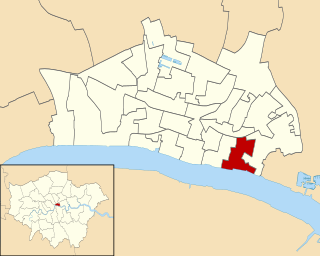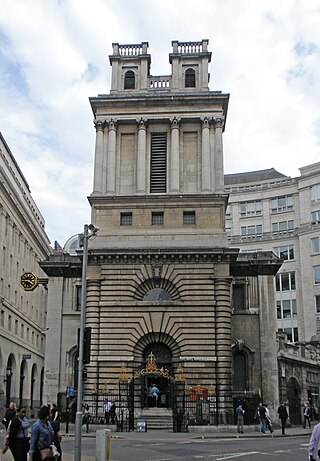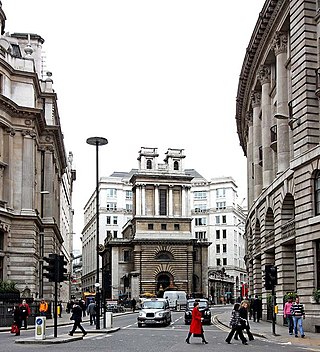
The subterranean or underground rivers of London are or were the direct or indirect tributaries of the upper estuary of the Thames, that were built over during the growth of the metropolis of London. They now flow through culverts, with some of them now integral parts of London's sewerage system and diverted accordingly.

Aldgate was a gate in the former defensive wall around the City of London. It gives its name to Aldgate High Street, the first stretch of the A11 road, which included the site of the former gate.

Gracechurch Street is a main road in the City of London, the historic and financial centre of London, which is designated the A1213.

Billingsgate is one of the 25 Wards of the City of London. This small City Ward is situated on the north bank of the River Thames between London Bridge and Tower Bridge in the south-east of the Square Mile.

St Mary Woolnoth is an Anglican church in the City of London, located on the corner of Lombard Street and King William Street near Bank junction. The present building is one of the Queen Anne Churches, designed by Nicholas Hawksmoor. The parish church continues to be actively used for services, with Holy Communion every Tuesday. St Mary Woolnoth lies in the ward of Langbourn.
The Langbourne or Lorteburn is reputed to be a lost river, which may have run in the east of the City of London and gave its name to the Langbourn ward of the city. If it existed, the Langbourne was a small stream or streams, arising in the vicinity of Aldgate and either joining the Walbrook or flowing directly into the Thames. The river is seldom included on maps or lists of lost rivers, and its existence is denied by Nicholas Barton, in his 1962 book Lost Rivers of London, but in more recent work David Bentley argues for its existence.

Fenchurch Street is a street in London linking Aldgate at its eastern end with Lombard Street and Gracechurch Street in the west. It is a well-known thoroughfare in the City of London financial district and is the site of many corporate offices and headquarters. The name "Fenchurch" means "church in the fenny or marshy ground" and presumably refers to St Gabriel Fenchurch, which stood at the junction of Fenchurch Street and Cullum Street until it was destroyed by the Great Fire.

The Walbrook is a subterranean river in London. It gives its name to the Walbrook City ward and to a nearby street. It played an important role in the Roman settlement of Londinium.

St Edmund, King and Martyr, is an Anglican church in Lombard Street, in the City of London, dedicated to St Edmund the Martyr.

St Benet Gracechurch, so called because a haymarket existed nearby (Cobb), was a parish church in the City of London. First recorded in the 11th century, it was destroyed in the Great Fire of London of 1666 and rebuilt by the office of Sir Christopher Wren. The church was demolished in 1868.

The Worshipful Company of Parish Clerks is one of the Guilds of the City of London. It has no livery, because "in the 16th century, the Parish Clerks declined to take the Livery on the grounds that the surplice was older than the Livery and was the proper garb of members of the Company." It is not, therefore, technically a livery company although to all intents and purposes it acts as such. It is one of two such historic companies without livery, the other being the Company of Watermen and Lightermen.

St Nicholas Acons was a parish church in the City of London. In existence by the late 11th century, it was destroyed during the Great Fire of London of 1666 and not rebuilt.

Candlewick is a small ward, one of the 25 ancient wards in the City of London.

All Hallows Lombard Street, also seen with descriptor Gracechurch Street, was a parish church in the City of London. It stood behind thin buildings fronting both streets, in Langbourn Ward, The west and south sides faced into Ball Alley. Of medieval origin, it was rebuilt following the Great Fire of London. It was demolished in 1937; its tower was reconstructed at Twickenham as part of the new church of All Hallows, which also received its bells and complete interior fittings.

St Dionis Backchurch was a parish church in the Langbourn ward of the City of London. Of medieval origin, it was rebuilt after the Great Fire of London to the designs of Christopher Wren and demolished in 1878.

St Mary Woolchurch Haw was a parish church in the City of London, destroyed in the Great Fire of London of 1666 and not rebuilt. It came within the ward of Walbrook.

St. Leonard, Eastcheap, sometimes referred to as St Leonard Milkchurch, was a parish church in the City of London. Of medieval origin, it was destroyed in the Great Fire of London in 1666 and not rebuilt. The site of the church was retained as a graveyard.

Lombard Street is a street notable for its connections with the City of London's merchant, banking and insurance industries, stretching back to medieval times.

Bank Junction is a major road junction in the City of London, the historic and financial centre of London, at which nine streets converge and where traffic is controlled by traffic lights and give-way lines. It is named after the nearby Bank of England. Directly underneath it is one of the ticket halls of Bank station, one of the busiest stations on the London Underground.






















